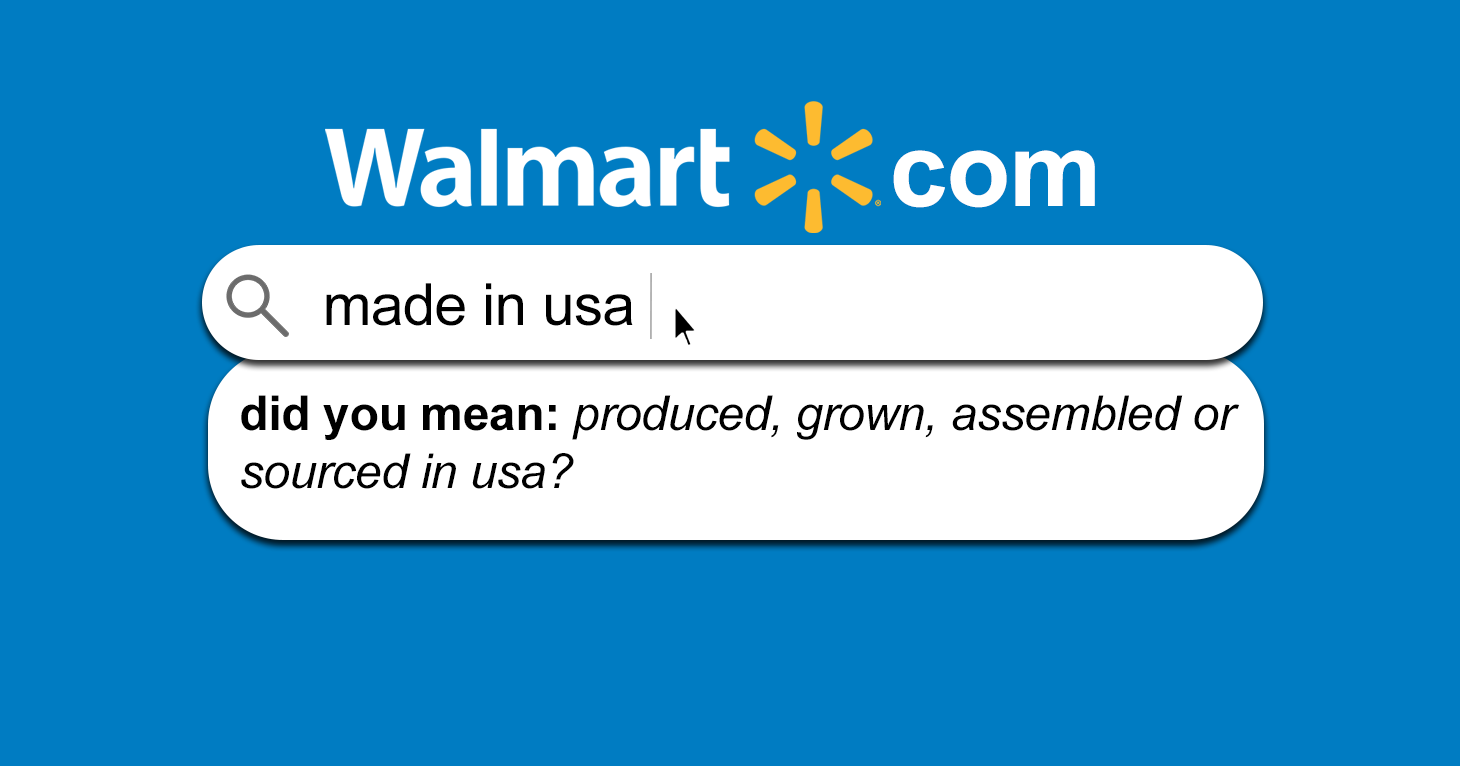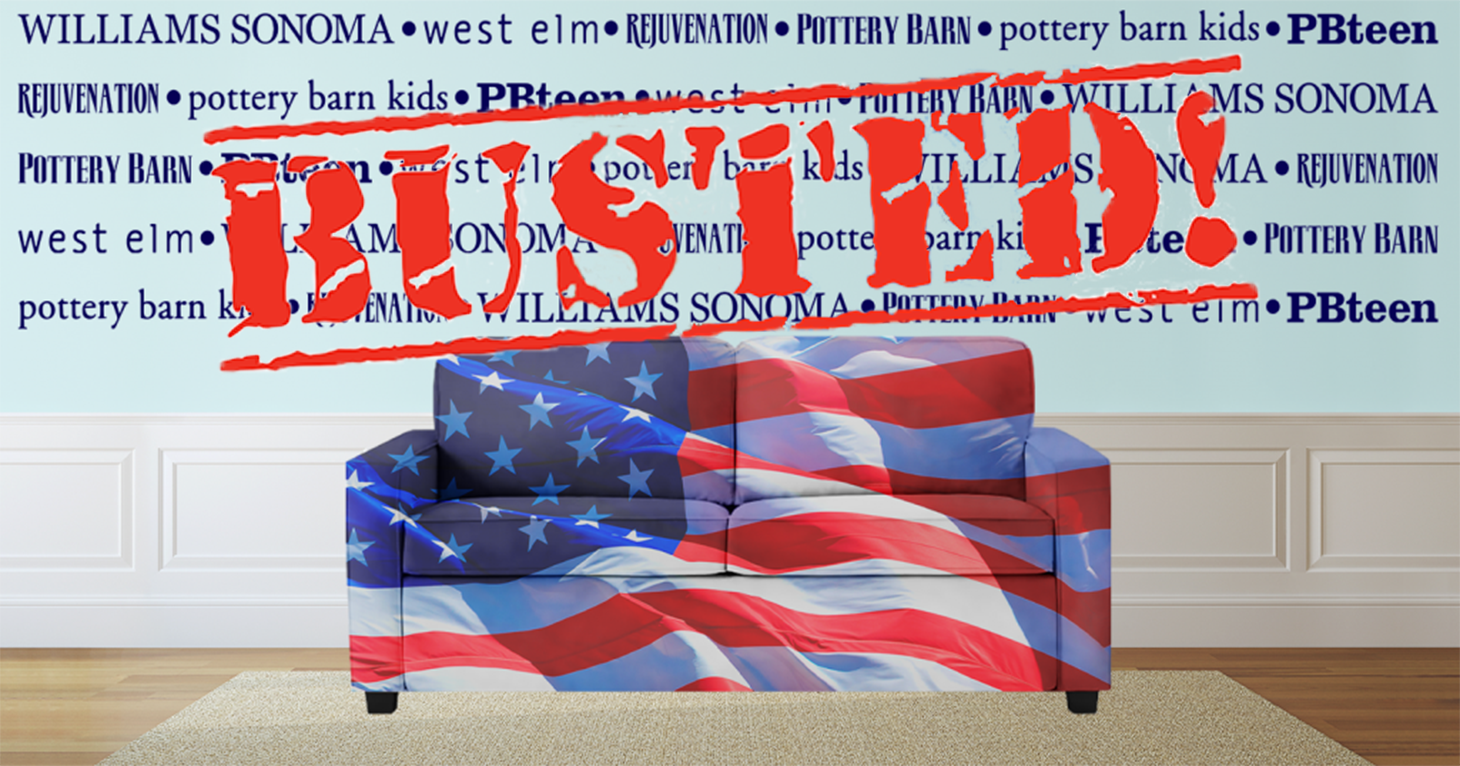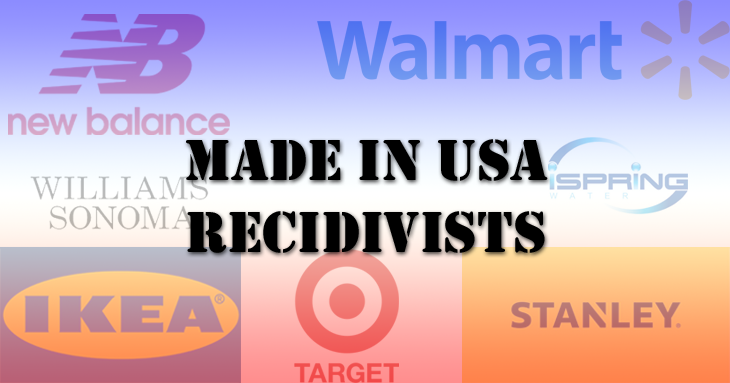
TINA’s Take: FTC Takes Crucial Step Forward in Holding Deceptive Made in USA Marketers Accountable
FTC finalizes its Made in USA Labeling Rule.
Walmart attempts to redefine what it legally means to be "made" in the USA.
|
UPDATE 2/11/21: Walmart has quietly removed a link on its website to “Find American-Made Products on Walmart.com” that had led to nearly 2,000 “made in usa” listings and replaced it with a link to a company blog published in 2019 about a woman who found work at a factory that produces furnace filters for Walmart. This comes after TINA.org filed a complaint with the FTC. Our original story follows.
For years, Walmart has misrepresented its American jobs initiative as a multibillion-dollar investment in products that meet the federal definition of “made” in the USA. Its latest trick, according to the most recent TINA.org investigation into Walmart’s deceptive made in the USA claims: an attempt to redefine the legal standard itself.
What the law says: Under the FTC’s Made in USA standard, only products that are “all or virtually all” made in the United States can be marketed as “made” in the USA or “made” in America. These are what the FTC calls unqualified U.S.-origin claims. The FTC has said in staff closing letters to made in the USA marketers that terms like “manufactured” and “built” also likely suggest to consumers that the product advertised is “all or virtually all” made in the United States, meaning it contains no – or negligible – foreign content. When that is not the case and the product advertised contains an amount of foreign content that is more than negligible, under the legal standard marketers can say things like “assembled” in the USA, though the FTC says to avoid such qualified claims unless the product still has a significant amount of U.S. content or U.S. processing. When making qualified claims like “Made in the USA with domestic and imported parts,” the FTC requires that the qualifying language – in this example, “with domestic and imported parts” – be clear and conspicuous. That is to say, the qualifying language must be easy for consumers to notice and, once they’ve noticed it, understand what it means. In the end, the FTC says: “A qualified Made in USA claim, like an unqualified claim, must be truthful and substantiated.”
What Walmart says: Whereas the FTC distinguishes between unqualified and qualified U.S.-origin claims, Walmart’s definition of “made” in the USA mashes them together. In a “Made in America” TV commercial that aired during the NFL playoffs over the weekend and that Walmart has spent more than $8 million on since it debuted last October according to ad-tracking firm iSpot, Walmart falsely suggests that “made” in America means the same as “produced,” “grown,” “assembled” or “sourced” in the USA. (Of note, the FTC cautions against the use of general terms like “produced” in the USA, saying, “Words like these are unlikely to convey a message limited to a particular process. Additional qualification probably is necessary to describe a product that is not ‘all or virtually all’ made in the U.S.”)
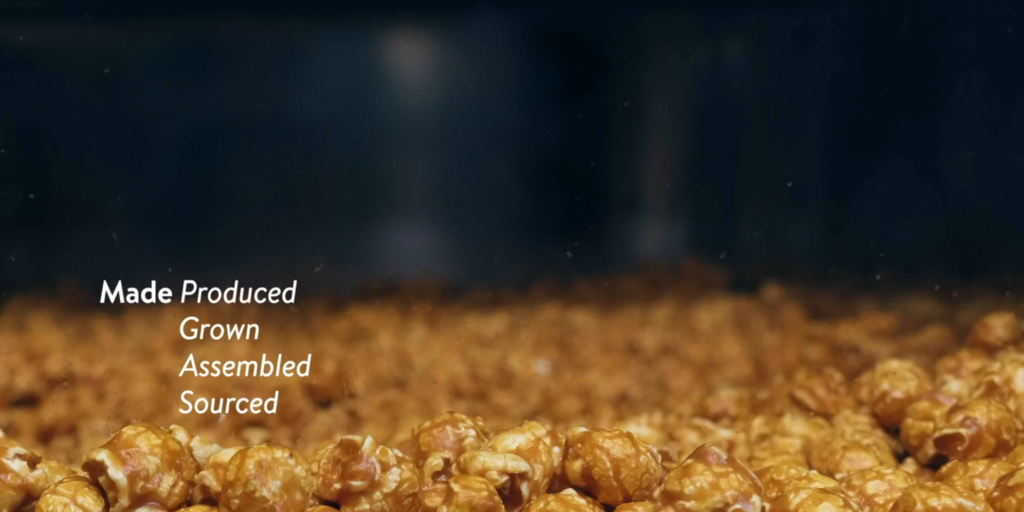
Based on this broader definition of “made” in the USA, Walmart claimed in a Facebook ad last fall that “[n]early two thirds of Walmart products are made in America.”
What a TINA.org investigation found: If you’re going to attempt to rewrite the rules for what it means to be “made” in the USA, you might want to cover your tracks. Yet Walmart leaves plenty of breadcrumbs that show many of its “American-made” products don’t meet the FTC’s “all or virtually all” standard for unqualified U.S.-origin claims. Specifically, country-of-origin information on the product pages of more than 40 “made in usa” listings reveal that the products contain imported parts, a TINA.org investigation found.
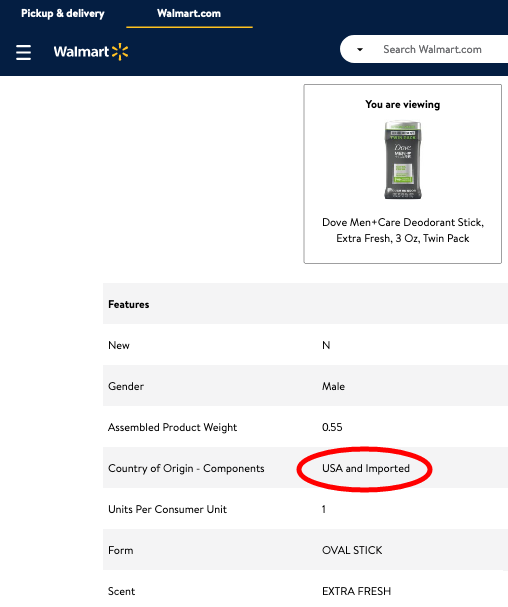
Getting to these “made in usa” listings is a bit of a journey, despite Walmart’s claim that its website makes it “easy for customers to buy products from U.S. suppliers,” which perhaps should not be confused with U.S. suppliers that sell products that meet the government’s definition of “made” in the USA. Additional steps are required after searching “made in usa” or “made in america” on Walmart.com, both of which bring up an “America at Work” page with the “Made in America” commercial but no product listings. To view the products that Walmart has determined meet its definition of “made” in the USA, consumers must scroll down the page, past the video, and click a link to “Find American-Made Products on Walmart.com.” Then, after clicking “Shop Walmart.com,” Walmart shows the search results for “made in usa,” which include everything from deodorant to dryer sheets to plastic storage containers and toothbrushes, with a number of products advertised as best sellers.
Consumers may be surprised to find that the website only lists around 2,000 products in the “made in usa” filter, given Walmart’s claim that almost two-thirds of its products are made in America and there are millions of products for sale on Walmart.com. But the truth is consumers can’t be certain any of these products meet the FTC’s definition of “made” in the USA without taking additional steps to verify country-of-origin information, such as checking the manufacturer website, because of how Walmart is attempting to redefine the legal standard.
What TINA.org did: On Tuesday, TINA.org filed a complaint with the FTC urging the agency to reopen an investigation into Walmart that it had closed in 2015 after receiving assurances from the company that it had removed a bevy of U.S.-origin claims from its website. That inquiry was sparked by a previous TINA.org complaint to the FTC regarding made in the USA misrepresentations on Walmart’s website earlier that year. At the time, Walmart attributed the USA labeling issues to “coding errors,” among other things.
Go deeper: Among the more than 40 products in TINA.org’s sampling are three Hoover carpet cleaners, each brandishing a “Made in the USA” label in search results and on product pages. TINA.org has seen – and scrutinized – this label before. It’s the same one Hoover uses on its own website, where the fine print on the bottom half of the label “with globally sourced components” is just as inconspicuous as it is on Walmart’s website. As discussed above, the FTC requires that such qualifying language in modified U.S.-origin claims be conspicuous or easy to spot so that consumers don’t miss it. But the fact that Hoover adds this qualifying language in the first place points to something larger: an admission that its carpet cleaners contain an amount of foreign content that is more than negligible, prohibiting the company or Walmart from marketing the products simply as “Made in the USA” or “American-made.”
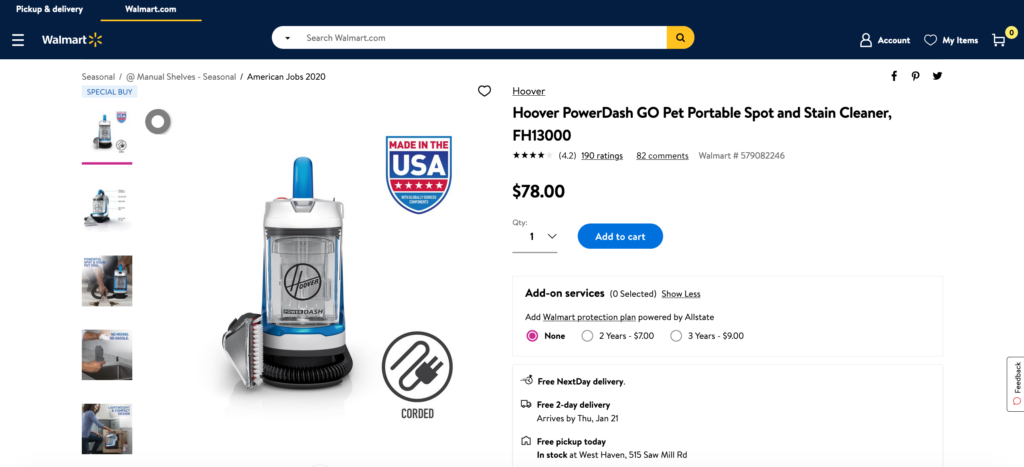
Like with other listings, Walmart does not identify the country or countries of origin of the “globally sourced components” in the three Hoover carpet cleaners appearing on its website in search results for “made in usa.” Walmart says in an ineffective disclaimer on all product pages: “We aim to show you accurate product information. Manufacturers, suppliers and others provide what you see here, and we have not verified it.” Last October, as part of an inquiry into Hoover’s made in the USA claims, including its USA label, TINA.org reached out to the company to inquire, among other things, about the source of these global components. The vacuum maker never responded to our email. However, according to a class-action lawsuit filed against Hoover’s parent company this month that raises many of the same issues flagged by TINA.org in an ad alert published three months earlier, the company receives “most” of the parts and components for its vacuum cleaners from China.
What’s next: Interest in made in the USA products has only grown since Walmart launched its American jobs initiative in 2013. The pandemic has put a spotlight on global supply chains, raising country-of-origin concerns among consumers. Based on its own data, Walmart claims that “Made in USA” is a strong driver of purchasing decisions, second only to price, and that “85% of moms said it is important for a retailer to sell ‘Made in USA’ products.”
Meanwhile, Walmart’s troubles right now extend beyond deceptive made in the USA claims: In December, the Justice Department filed a civil suit against the company for allegedly helping fuel the opioid crisis. But with the incoming Biden administration proposing a $700 billion “Buy American” campaign, rest assured that Walmart will continue to push products that it says are American-made, whether or not that is true, until it is held accountable for its deceptive made in the USA marketing.
As TINA.org wrote in its complaint letter to the FTC:
Walmart’s history of deceptive Made in USA marketing claims on its website now spans more than five years and is exacerbated by consumers’ current need and desire to shop online during the global pandemic. Obviously, as the world’s largest retailer, the company’s continuing failure to address these issues cannot be related to a lack of resources or sophistication.
TINA.org reached out to Walmart for comment. Check back for updates.
Read more about TINA.org’s investigations into Walmart’s deceptive made in the USA claims here.
FTC finalizes its Made in USA Labeling Rule.
FTC takes action against home goods and kitchenware company for misleading made in the USA claims.
1. New Balance In 1996, the FTC brought an administrative action against New Balance for making deceptive U.S.-origin claims about its sneakers. Since at least 2009, the company has marketed…
